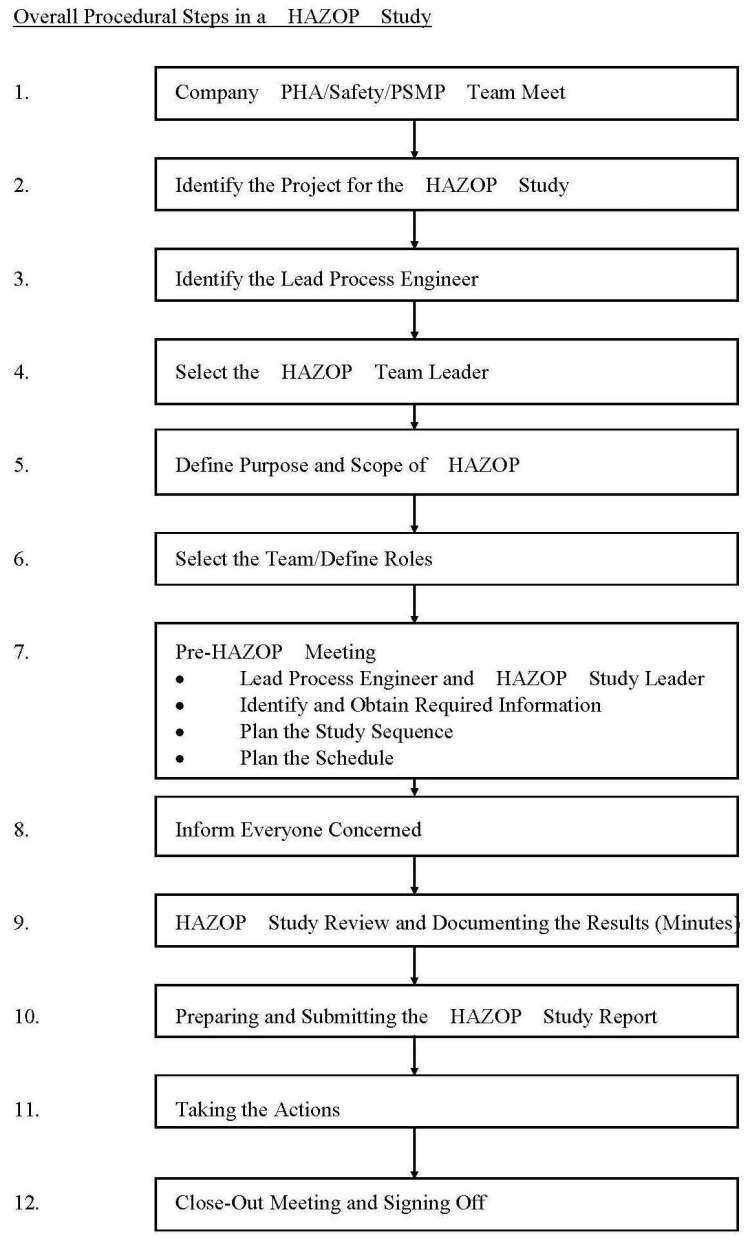
WHAT is a HAZOP?
A hazard and operability study (or HAZOP) is a systematic, critical examination by a team of the engineering and operating intentions of a process to assess the hazard potential of mal-operation or mal-function of individual items of equipment and the consequential effects on the facility as a whole.
It is quite normal to carry out safety reviews. These may take different forms. Experts may be consulted in isolation, without reference to each other. They may instead be gathered in lengthy meetings to discuss the particular topic. Hazops are meetings with a distinct structure, the structure imposing a certain organization, to enhance effectiveness. They are a generalized study technique, equally applicable to microchip manufacture, pharmaceutical synthesis, effluent plant operation or any process.
They should not be seen, however, as a solution to all ills, the ultimate review. The procedure is only anther tool in the safety locker and should be seen as complementary to other techniques. Indeed it is best applied as one stage of a multi-stage procedure, applying different techniques as relevant to each stage. It does not replace, but rather supplements, existing Codes of Practice. Neither can it totally substitute for experience. But, both Codes of Practice and experience are evolved from existing situations. Innovative developments require a review which investigates the unknown. Hazops are a systematic, logical approach to determining problems.
WHY is a HAZOP carried out ?
The reasons for carrying out hazard and operability studies, are :
i. Primarily, to identify hazards, and
ii. To a lesser extent, to resolve these hazards.
In saying this, hazards are very generally defined. They are understood to be events, which :-
i. Lead to injury of people, either inside or outside the plant.
ii. Injure the environment.
iii. Insult the environment. Harmful effects may not occur, but disturbance itself is unacceptable.
iv. Damage the plant, an obvious hazard.
v. Result in loss of production quantity, quality or schedule.
In practice, some resolution of hazards is normally accepted. However a careful balance must be maintained to ensure that the primary purpose of hazard identification is not compromised.
WHEN is a HAZOP carried out ?
The timing of a hazard and operability study is determined by the objectives of a study, and in turn determines the benefits that may be gained. The outline concept of a process may be examined to highlight any major omissions or significant features. As further detailing is carried out, e.g. when the process design is complete, the full study procedure may best be applied. Operating procedures may be examined to ensure that all eventualities have been considered. Modifications including so-called “minor modifications”, generally benefit from a rigorous study. Often an apparently simple, uncomplicated modification can give rise to a greater problem than it was intended to solve. Existing plant and new equipment are other examples of topics that may benefit from study.
Therefore a project may be studied several times in its life-time.
Despite these comments there is quite a distinct benefit from carrying out a proper HAZOP Study in terms of the correct timing and to obtain the maximum cost benefit. Therefore, a hazop cannot be carried out before the line diagrams (or process instrumentation diagrams as they are often called) are complete. It should be carried out as soon as possible thereafter.
If an existing plant is being studied the first step is to bring the line diagrams up to date or check that they are up-to-date. Carrying out a hazop on an incorrect line diagram is the most useless occupation in the world. It is as effective as setting out on a journey with railway timetable ten years out of date.
A hazop takes 1.5-3 hours per main plant item (still, furnace, reactor, heater, etc.). If the plant is similar to an existing one it will take 1.5 hours per item but if the process is new it may take 3 hours per item.
Meetings are usually restricted to 3 hours, twice per day, 2 or 3 or even 4 days per week, to give the team time to attend to their other duties and because the imagination tires after 3 hours at a stretch.
The hazop on a large project may take several months, even with 2 or 3 teams working in parallel on different sections of the plant. It is thus necessary to either :
a) Hold up detailed design and construction until the hazop is complete, or
b) Allow detailed design and construction to go ahead and risk having to modify the detailed design or even alter the plant when the results of the hazop are known.
Ideally, the design should be planned to allow time for (a) but if completion is urgent (b) may have to accepted – but this is not a widely accepted option due to the cost implications.
A preliminary hazop may be carried out on the flowsheet before detailed design starts. This will take much less time than the hazop of the line diagrams and will identify ‘area’ of the process of a particular hazardous nature. It provides a more “structured” and “systematic” approach than a preliminary design review – but NOT the detailed analytical data of a true P&ID HAZOP.


